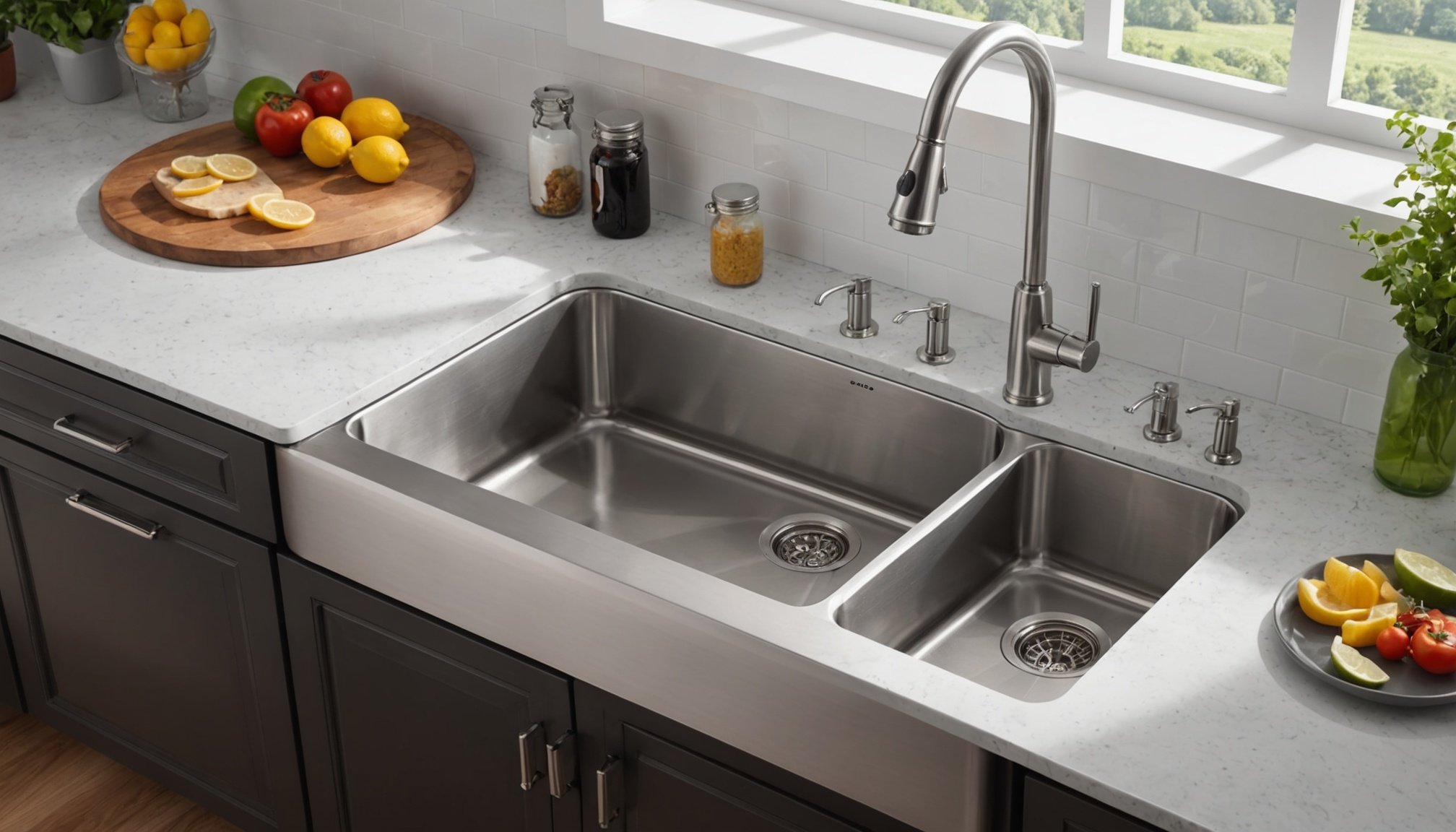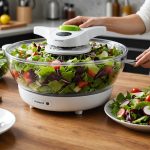Ultimate Guide to Choosing the Perfect Heavy-Duty Kitchen Sink: Key Factors to Consider
When it comes to outfitting your kitchen with the perfect sink, the decision can be overwhelming, given the myriad of options available. Whether you’re renovating your entire kitchen or simply looking to upgrade your current sink, this guide will walk you through the key factors to consider, helping you make an informed decision that suits your needs, style, and budget.
Understanding Your Kitchen Space and Needs
Before diving into the world of kitchen sinks, it’s crucial to assess your kitchen space and your specific needs. Here are a few things to consider:
Have you seen this : Transform your minimalist kitchen with the latest splashback design trends
Measuring Your Space
Ensure you have accurate measurements of your kitchen countertop and the space where the sink will be installed. This includes the width, depth, and any obstructions such as plumbing fixtures or electrical outlets[4].
Lifestyle and Usage
Think about how you use your kitchen. If you’re an avid cook, you might prefer a sink with multiple basins or a larger single bowl to accommodate pots and pans. For those with limited space, an undermount sink or a compact farmhouse sink could be ideal[2].
Also to see : Elevate your kitchen aesthetics: ultimate tips for designing a flourishing herb wall
Accessibility
If you’re designing a kitchen for accessibility, consider the height of the sink, the clearance under it, and the placement of faucets and other fixtures. For example, a sink with a degagement (clearance) of at least 70 cm under it is essential for wheelchair accessibility[5].
Choosing the Right Material
The material of your kitchen sink is one of the most critical decisions you’ll make. Here’s a detailed look at the most common materials:
Stainless Steel Sinks
Stainless steel sinks are both versatile and practical, making them the most popular choice. They are durable, resistant to damage, and relatively easy to maintain. The gauge of the steel is important; lower numbers indicate thicker material, with 16-gauge being the most heavy-duty and 20-gauge being more budget-friendly[2][4].
Pros:
- Durable and resistant to damage
- Easy to clean and maintain
- Cost-effective
- Available in polished or brushed finishes
Cons:
- Can scratch over time
- Noisy when items are dropped into the sink
Composite Stone Sinks
Composite stone sinks, also known as engineered stone, are made by combining acrylic resin with metal crystals. They offer a wide range of colors and can blend seamlessly with your countertops.
Pros:
- Variety of colors available
- Non-porous material, hygienic and resistant to scratches
- Easy to clean
Cons:
- Prone to stains
- Not as hard or heat-resistant as natural stone
- More expensive than stainless steel[2][4].
Granite and Natural Stone Sinks
Granite and natural stone sinks provide a luxurious touch to any kitchen. They are highly durable and resistant to scratches, stains, and heat.
Pros:
- Unique and elegant appearance
- Highly durable and resistant
- Can withstand high temperatures
Cons:
- Expensive
- Requires basic care and cleaning to maintain the look[2][4].
Porcelain Enamel-Coated Sinks
Porcelain enamel-coated sinks have a glazed surface that makes them easy to clean and resistant to stains. However, they can be prone to cracking, which can harbor bacteria.
Pros:
- Easy to clean
- Resistant to stains
- Available in various colors
Cons:
- Prone to cracking
- Repairing can be challenging[4].
Sink Styles and Designs
The style and design of your sink can significantly impact the overall look and functionality of your kitchen.
Undermount Sinks
Undermount sinks are installed beneath the countertop, creating a sleek and modern look. They are easy to clean and provide a seamless integration with the countertop.
Pros:
- Sleek and modern appearance
- Easy to clean
- Provides additional counter space
Cons:
- Installation can be more complex
- Requires specific countertop material[2][4].
Farmhouse Sinks
Farmhouse sinks, also known as apron-front sinks, are a classic choice that adds a touch of elegance to any kitchen. They are often larger and deeper than standard sinks.
Pros:
- Traditional and elegant appearance
- Larger and deeper basins
- Easy to clean
Cons:
- Heavier and often more expensive
- Requires specific installation[2].
Drop-In Sinks
Drop-in sinks are the most common type and are installed directly into a cutout in the countertop.
Pros:
- Easy to install
- Cost-effective
- Wide range of materials and styles available
Cons:
- Less sleek appearance compared to undermount sinks
- Can be less durable depending on the material[4].
Additional Features to Consider
When choosing a kitchen sink, there are several additional features to consider that can enhance functionality and convenience.
Number of Basins
Decide whether you prefer a single bowl, double bowl, or even a triple basin sink. Double basin sinks are particularly useful for separating washing and rinsing tasks.
Faucet Compatibility
Ensure the sink you choose is compatible with your preferred faucet type. Some sinks come with pre-drilled faucet holes, while others may require additional installation[2].
Accessories and Integrations
Some sinks come with integrated accessories such as drying racks, strainers, and silicone bottom grids. These can enhance the functionality of your sink and make kitchen tasks easier[2].
Maintenance and Cleaning
The ease of maintenance and cleaning is a crucial factor in choosing the right sink.
Easy Clean Materials
Materials like stainless steel and composite stone are known for their ease of cleaning. They are non-porous and resistant to scratches and stains[2][4].
Regular Maintenance Tips
- Clean your sink regularly with mild soap and water.
- Avoid using abrasive cleaners that can scratch the surface.
- For stainless steel sinks, use a stainless steel cleaner to maintain the polished finish.
- For composite stone sinks, avoid exposing them to excessive heat or sharp utensils[2][4].
Brand Recommendations and Quality
Choosing a reputable brand can ensure you get a high-quality sink that meets your needs.
Blanco
Blanco is a well-known brand in the kitchen sink industry, offering a wide range of materials including stainless steel, granite, and ceramic. Their patented Silgranit ultra-hard engineered stone is highly resistant to scratches and heat[4].
Quote from Octavio Estrada, Design Experience Manager at Block Renovation:
“Composite stone sinks offer a variety of colors and can blend seamlessly with your countertops. However, they require more maintenance since they are easier to stain over time.”
Comparative Table of Common Sink Materials
Here is a comparative table to help you visualize the pros and cons of different sink materials:
| Material | Pros | Cons | Price Range |
|---|---|---|---|
| Stainless Steel | Durable, easy to clean, cost-effective | Can scratch, noisy | $300-$1,500 |
| Composite Stone | Variety of colors, non-porous, easy to clean | Prone to stains, not as hard as natural stone | $500-$2,500 |
| Granite/Natural Stone | Unique appearance, highly durable, resistant to scratches and heat | Expensive, requires basic care | $1,000-$3,500 |
| Porcelain Enamel-Coated | Easy to clean, resistant to stains, various colors | Prone to cracking, challenging to repair | $400-$2,000 |
Practical Insights and Actionable Advice
Here are some practical insights and actionable advice to help you make the best decision:
Measure Twice, Install Once
Ensure you have accurate measurements before purchasing your sink to avoid any installation issues.
Consider Your Lifestyle
Think about your cooking habits and the type of sink that would best suit your needs. For example, if you frequently wash large pots and pans, a deeper single bowl sink might be ideal.
Read Reviews and Ask for Recommendations
Look up reviews from other users and ask for recommendations from friends or professionals to get a better understanding of the sink’s performance in real-world conditions.
Choosing the perfect heavy-duty kitchen sink is a significant decision that can impact the functionality, style, and overall enjoyment of your kitchen. By considering factors such as material, style, and additional features, you can find a sink that not only meets but exceeds your expectations.
Whether you opt for the durability of stainless steel, the elegance of granite, or the practicality of composite stone, ensuring that your sink aligns with your kitchen design and lifestyle is key. Remember to maintain your sink regularly to keep it looking its best and functioning optimally.
In the words of Alice Moszczynski, an interior designer at Planner 5D:
“Stainless steel is both versatile and practical, making it the most popular choice. However, it’s important to consider the gauge of the steel and the finish to ensure it fits your kitchen style and needs.”
By following this guide, you’ll be well on your way to selecting a kitchen sink that enhances your cooking experience and adds a touch of sophistication to your kitchen.











